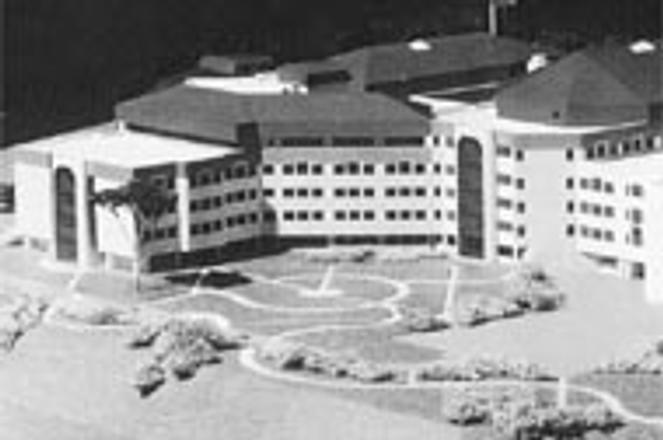State of the art health care. The new cardialogy hospital will treat the number one cause of death in Slovakia, heart disease.
Slovakia's first world-class hospital has been established to treat heart disease, currently the cause of just over half of all deaths in the country. Last year an estimated 3,500 cardiac surgeries were needed in Slovakia, of which about 800 were performed.
Starting in March, The Slovak Institute of Heart Disease (Slovenský ústav Srdcových Chorôb - SUSCH) will provide diagnostic care, treatment and surgery for up to 230 Slovaks with heart disease, while providing a center for cardiac research and medical training.
The new hospital, located in Bratislava's Kramáre district, was designed by the Belgian architectural firm Tractabel, which negotiated a loan from the Belgian General Bank in Brussels for $67 million to finance the hospital's construction, built by the Slovak construction firm Hydrostav.
The loan also covers the cost of all new equipment installed at the hospital, most of which was imported. The Slovak government is scheduled to repay the loan-the first ever extended to Slovakia by a Belgian bank-by the year 2006.
For Slovakia, "this hospital is unique," said Jirí Chochol, SUSCH's financial director, "Most general hospitals contain several departments of which a cardiovascular section is only one. This will be the first hospital in Slovakia to deal specifically with cardiac illnesses." Chochol said that all types of heart-related vascular diseases save for so-called "dirty" surgery, such as amputations, will be administered at SUSCH, which has six open-heart operating rooms for cardiac procedures including heart-transplant surgeries, and is advanced enough, in Chochol's words, "to compare with any first-rate hospital worldwide."
Robert Hatala, an associate professor of SUSCH, expects the recorded mortality rate for diagnosed cardiac-related deaths in Slovakia to rise, which makes the need for the new hospital, in his words, "urgent." Hatala, a cardiac surgeon at Bratislava's Cardiovascular Hospital on Palisady ulica (which will become a general hospital later this year), said that the disparity between the number of heart-related deaths and cardiological procedures from year to year partly reflects the rising standard of Slovak diagnostic care.
"Diagnostic techniques [in Slovakia] are being improved," Hatala said. "This actually accounts for the 'rise' in the number of cardiac-diagnosed cases over time; whereas previously a patient who had not been properly diagnosed would have simply had a heart attack and died, increasingly, people are being correctly diagnosed and treated accordingly."
However, Hatala added, "There is definitely a very strong need for this new center. We have a very high incidence of heart disease, especially of coronary artery disease[specifically, the narrowing of coronary blood vessels]. To control the whole problem, you have to start with prevention: cutting down on cigarettes, cutting back on eating fatty foods, and so on, [personal decisions] which can take decades" to affect society.
New equipment
Among the recently developed cardiovascular procedures that the new hospital will employ on a wider basis are several types of therapy involving catheter intervention. The new hospital will also have new German-made x-ray machines to replace the 4-10 year old equipment in use at the Cardiovascular Hospital. The cost of one such machine is roughly $2 million, Hatala said.
Electrocardiograph (EKG) monitors will be "quite sophisticated," according to Hatala, who said that SUSCH's cardiological department will have "16 fully monitored beds" and 12 telemetric monitors, or "mobile EKGs."
"We are also quite a big center for implantingcardiac pacemakers, including the most recently developed type, called ICDs [Implantable Cardioverter Defibrillator], which prevents sudden deaths due to arrhthmia," Hatala said. This device, which weighs about 100 grams, delivers electrical therapy which can terminate arrythmia and prevent sudden deaths.
"The price of this technology is really considerable," Hatala said. "You must calculate that in western Europe an angioplasty [the dilation of blood vessels with a balloon catheter] costs about $4.9-$7 thousand; an ablation [a type of cathetic intervention which localizes abnormal electrical activity in the heart, which are then terminated with electrical radio-wave impulses which heat the heart muscle-tissue] costs $10.5-$21 thousand; open-heart surgery costs about $35 thousand. Disposable equipment such as catheters constitutes about 50 percent of the cost of the operations. Let's say the surgeons perform five open-heart surgeries per day; you can see the cost will be enormous."
On the other hand, Hatala said, "due to the lower costs of our own labor, we can perform this kind of intervention at about half that for the same procedure in Germany," though he noted that practically all of the hospital's income from operations is re-invested in disposable equipment. "Insurance companies don't cover the cost of the dsiposable material we need," Hatala said. "This means that the more people we cure, the more money we lose." Hatala estimated the amount of investment in permanent equipment for the new facility at 200 million Sk.


